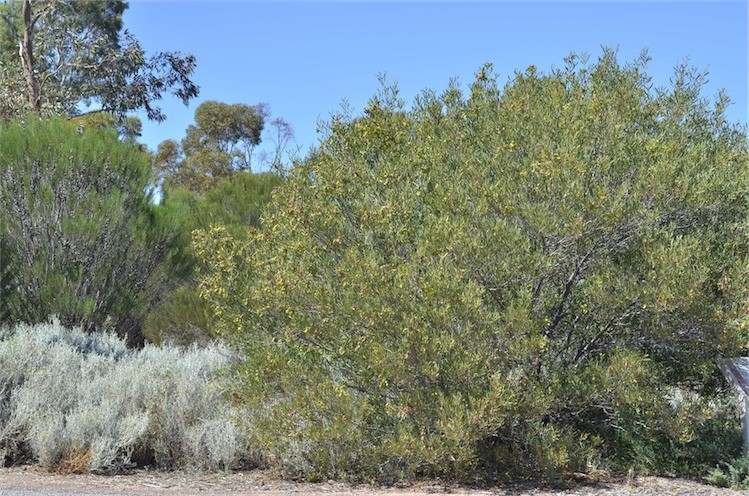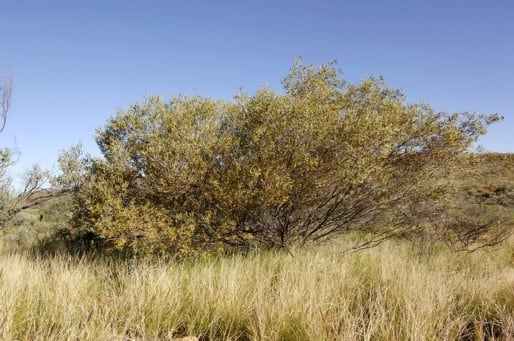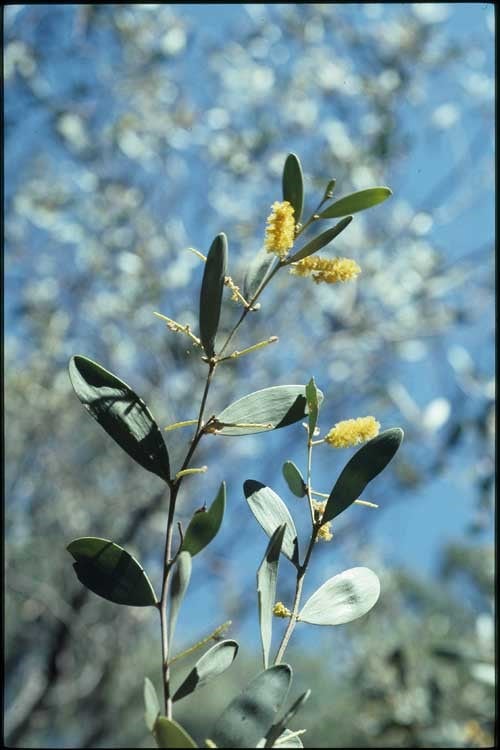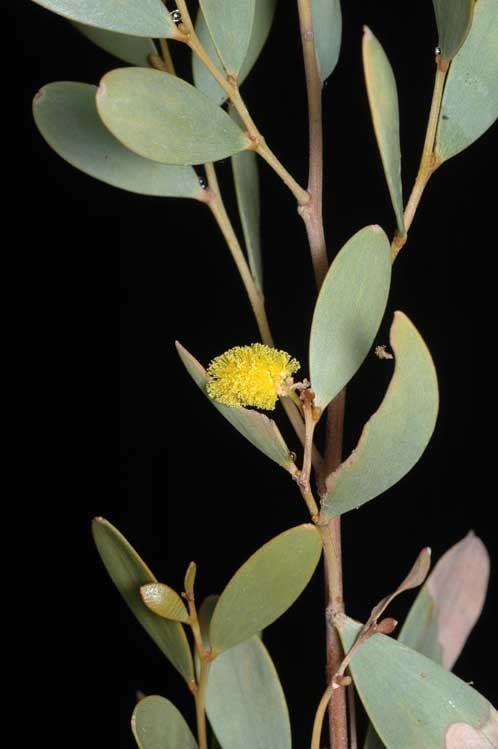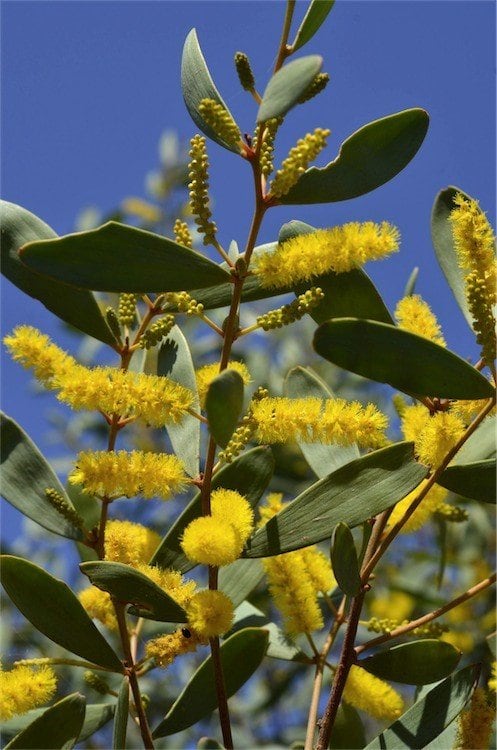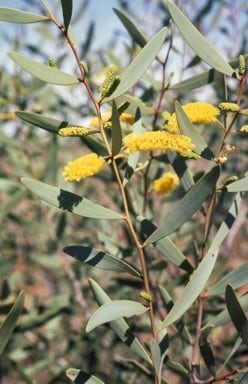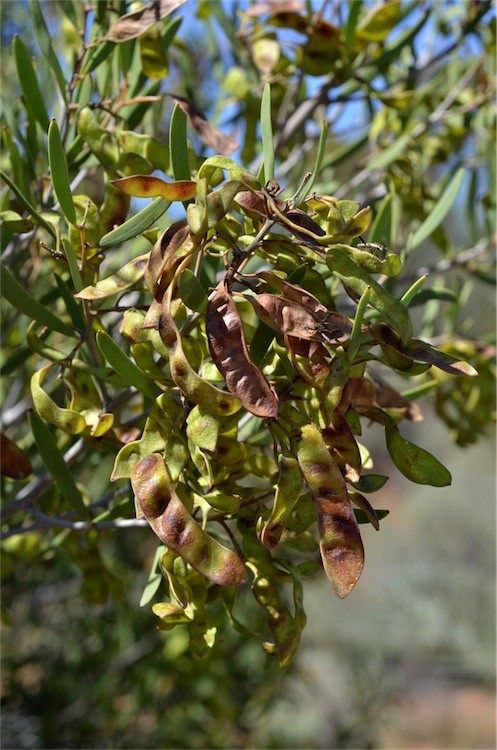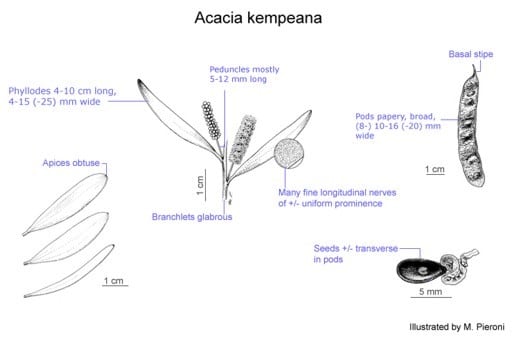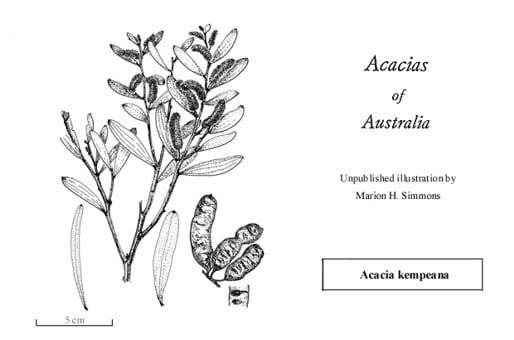Acacia kempeana F.Muell.
WATTLE
Acacias of Australia
Common Name
Witchetty Bush, Wanderrie Wattle
Family
Fabaceae
Distribution
Occurs in all mainland States except Vic. and N.S.W.
Description
Spreading shrub or tree to 5 m high, commonly multi-stemmed. Bark furrowed, usually grey or brown. Branchlets terete except at apices, grey or brownish, slightly scurfy, glabrous. Phyllodes oblong-elliptic to oblong-oblanceolate or narrowly elliptic, flat, straight or slightly incurved, 4–10 cm long, 4–15 (–25) mm wide, l:w = 3–13 (–17), with obtuse and often mucronulate apices, coriaceous, grey- or blue-green, glabrous, resinous when young, very finely multistriate with the parallel nerves very close together (rarely a few anastomosing) and of ±uniform prominence; gland ±basal. Peduncles 5–12 (–15) mm long, glabrous. Spikes 1 or 2 per upper axil, 1–2.5 cm long, dense, bright golden. Flowers 5-merous; calyx cupular, dissected to 1/3, hairy mostly at base; corolla 1.3–2 mm long, 2–2.5 times as long as calyx. Pods oblong to narrowly oblong, flat, 2–7 cm long, (0.8–) 1–1.6 (–2) cm wide, chartaceous, finely transversely reticulate, glabrous; stipitate. Seeds transverse to slightly oblique.
Phenology
Flowers Mar.–Aug., probably flowers whenever temperature and soil moisture are high. Fruiting mainly Aug.–Nov.
Habitat
Widely distributed in arid areas, where it occurs usually on stony hillsides or in coarse textured alluvial soils; often abundant in mulga woodlands on red sandy loam plains.
Specimens
W.A.: Berringarra Stn HS, J.S.Beard 6626 (NSW, PERTH). N.T.: Mt Gillen, Alice Springs, M.J.Barritt 373 (CANB, DNA, K, MEL, NSW). S.A.: 104 km N of Oodnadatta, P.L.Milthorpe 3061 (NSW). Qld: c. 155 km NW of Windorah, May 1973, [D.E.]Boyland (BRI), fide L.Pedley, Austrobaileya 1: 154 (1978).
Notes
Aborigines obtained witchetty grubs from the roots, as well as the bush providing edible gum and seed (A.Urban, Wildflowers & Pl. Centr. Australia 84, 1990). Details on fire tolerance and Aboriginal use of A. kempeana are given by P.Latz, Bushfires & Bushtucker 102 (1995). Arid zone pastoralists regard this species as a ‘last resort’ fodder; it has good palatability but low nutritive value and over-grazing will often cause death of plants.
Acacia kempeana as currently defined is very variable (especially in W.A.) and in need of critical revision. It is closely allied to A. sibirica and A. duriuscula; also related to A. aprepta. It is especially close to A. sibirica which is normally, but perhaps only arbitrarily, distinguished by its narrower pods (mostly 3–5 mm wide) with ±longitudinal seeds, and narrower, more elongate phyllodes (mostly 1–5 mm wide with l:w = 8–60). However, not all specimens can be confidently placed using these attributes. Further study of these two variable species in needed, not only to elucidate their complex patterns of variation, but also to clarify their taxonomic boundary. Phyllodes of A. kempeana sometimes superficially resemble those of A. petricola, but the two species are not especially closely related.
FOA Reference
Data derived from Flora of Australia Volumes 11A (2001), 11B (2001) and 12 (1998), products of ABRS, ©Commonwealth of Australia
Author
P.G.Kodela
Edited by B.R.Maslin
This identification key and fact sheets are available as a mobile application:
URL: https://apps.lucidcentral.org/wattle/
© Copyright 2018. All rights reserved.
